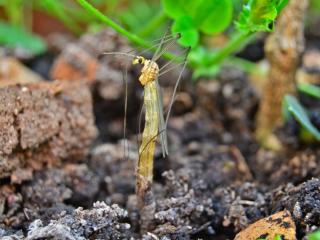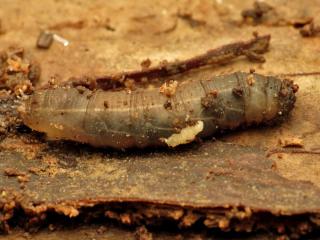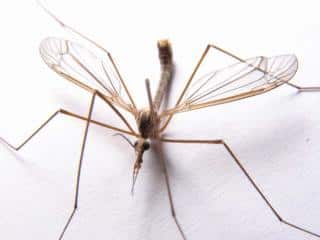

Though the adult cranefly doesn’t harm plants in the garden or vegetable patch, the same cannot be said for its larva. Cranefly larva (leatherjacket is a common example) will indeed devour roots of plants, killing them from below. Luckily this is not inevitable. There are ways to limit the damage they cause.
Cranefly key facts:
Phylum: Invertebrates
Class: Insects
Order: Diptera
Family: Tipulidae
An adult cranefly looks like an overgrown mosquito (but it doesn’t bite). It is medium-sized (between a half and a full inch, or between 1 and 2.5 cm). It has a slender body with long wings and long, thin legs. It clearly deserves the “daddy longlegs” moniker often used with children.
The cranefly larva has a brownish color and can measure up to 1½ inches (4 cm) at the end of its development. It resembles a large maggot at that stage.

In autumn, eggs hatch into larvae that start feeding on decomposing humus. After a short while, the maggots move on to eating live roots. They live in the upper layers of soil and burrow and feed even during winter. However, depending how intense the cold is, the mortality rate in any given year can reach 50 to 70%.
It is in spring that cranefly larva is most devastating. Warmer days give the plump cranefly larva a boost and they chow down on our beloved plant roots like never before!
Despite their impressive size, craneflies pose no danger to humans. They do not bite and exclusively feed on water and sap.

The action of cranefly larvae is often most striking in lawns: grass starts turning yellow in patches as early as January and the patch slowly turns completely bare.
In the vegetable garden, seedlings are vulnerable since these larvae eat young leaves. Established plants, especially lettuce, strawberry, turnip, cabbage, potato, and pea are most commonly affected.
For ornamental gardens, aside from lawns, these maggots also attack herbaceous and perennial plants.
Populations of cranefly larva can be regulated by natural predators such as hedgehogs, moles, shrews, and insect-eating birds (blackbird, song thrush, and starling). Adults, on the other hand, are often the target of bats (the pipistrelle bat is a good example of this).
Just like click beetle larva, a cranefly larva prefers moist areas. Hands-on work by gardeners during the key feeding periods helps limit the damage. Regular hoeing, raking, and weeding overturns soil and disrupts the larva’s proper development.
As with many pests, crop rotation is also a good means of control and prevention.

An additional tip is to trap cranefly larvae by placing a black plastic sheet on very moist soil in the evening (after rain or thorough watering). The next day, lift the sheet of plastic: you’ll see many fat maggots gathered underneath! All that’s left is to “collect” them.
As a last resort, in case of severe infestation, an insecticidal treatment based on pyrethrin is an option.
Tipula oleracea measures between just under an inch (between 1.5 and 2.5 cm). It has a grayish hue and a bulging, almost round thorax. Its main period of activity is in spring. However, in the warmer regions, a second generation may appear in autumn.
Tipula paludosa is very similar to the garden cranefly. It is mainly distinguished by its period of activity, which occurs in autumn.
Nephrotoma appendiculata measures up to ¾ inch (1.2 cm to 2 cm) in length. Its body is tinged with yellow and black, and its wings are grayish.
Nephrotoma crocata has a black body ringed with yellow bands. It measures just over half an inch, between 1.2 cm and 1.8 cm.